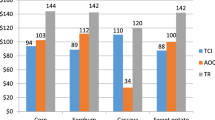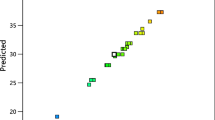Abstract
Cassava (Manihot esculenta) is a woody bush extensively cultivated as an annual crop in tropical and subtropical regions for its edible starchy tuberous root, a major source of carbohydrates. The main residue from its cultivation is the cassava stalk, which is normally used as soil fertilizer or in culture propagation. The main goal of this paper is to evaluate two routes (biochemical and thermochemical) for bioenergy production (ethanol and synthesis gas—electricity) using cassava stalk as raw material. A detailed techno-economic and energy assessment is carried out based on the simulation approach of both conversion routes to determine the production costs of main products and the overall energy efficiency of the processes. The electricity production costs vary from 0.008 to 0.037 USD/MJ, whereas the ethanol production costs range from 1.11 to 2.02 USD/L (including subsidies). The change in the production costs was observed due to the assumptions of the model, e.g., cassava stalk, transportation, and enzyme costs. The overall energy efficiency of the gasification and ethanol fermentation was 68.7 and 25.1%, respectively.








Similar content being viewed by others
References
Sivamani S, Chandrasekaran AP, Balajii M, Shanmugaprakash M, Hosseini-Bandegharaei A, Baskar R (2018) Evaluation of the potential of cassava-based residues for biofuels production. Rev Environ Sci Biotechnol 17:553–570. https://doi.org/10.1007/s11157-018-9475-0
Food and Agriculture Organization of the United States (FAO) (2017) Production of Cassava in the World
Ministerio de Agricultura y Desarrollo Rural (2017) Clúster de tubérculos en los departamentos de Bolívar, Córdoba y Sucre para las líneas productivas de Ñame, Yuca y Batata. Colombia
Red de Información y Comunicación del Sector Agropecuario de Colombia (AGRONET) (2018) Cassava crop production in Colombia
Tomei J, Helliwell R (2016) Food versus fuel? Going beyond biofuels. Land Use Policy 56:320–326. https://doi.org/10.1016/j.landusepol.2015.11.015
Veiga JPS, Valle TL, Feltran JC, Bizzo WA (2016) Characterization and productivity of cassava waste and its use as an energy source. Renew Energy 93:691–699. https://doi.org/10.1016/j.renene.2016.02.078
Klein C (2017) Handbook on cassava. Production, potential uses and recent advances. Nova Science Publisher Inc, New York
Okon A (2017) Prices of cassava stems drop to N400/bundle. In: Punch. https://punchng.com/prices-of-cassava-stems-drop-to-n400bundle/.
Zhu W, Lestander TA, Örberg H et al (2015) Cassava stems: a new resource to increase food and fuel production. GCB Bioenergy 7:72–83. https://doi.org/10.1111/gcbb.12112
Unidad de planeación Minero Energética (UPME) (2014) Law 1715 of 2014. Integration of non-conventional energy sources to the National Energetic System
Higueras D (2016) Law 1715. Friend of the stakeholders in renewable energies? Semana
CONPES (2008) Lineamientos de la política para promover la producción sostenible de biocombustibles en Colombia. Departamento Nacional de Planeación, Bogotá
de la República de Colombia C (2001) Ley 693 of 2001 - normas sobre el uso de alcoholes carburantes. Ministerio de Minas y Energía. Bogotá, Colombia
Asocaña (2019) General issues of sugarcane agroindustry: 2018–2019 annual report. Asocaña
García CA, Moncada J, Aristizábal Marulanda V, Cardona CA (2017) Techno-economic and energetic assessment of hydrogen production through gasification in the Colombian context: coffee cut-stems. Int J Hydrog Energy 42:5849–5864. https://doi.org/10.1016/j.ijheatmasstransfer.2017.09.038
Martín C, Wei M, Xiong S, Jönsson LJ (2017) Enhancing saccharification of cassava stems by starch hydrolysis prior to pretreatment. Ind Crop Prod 97:21–31. https://doi.org/10.1016/j.indcrop.2016.11.067
Wooley RJ, Putsche V (1996) Development of an ASPEN PLUS physical property database for biofuels components. Victoria:1–38
Carolan J, Joshi S, Dale B (2007) Technical and financial feasibility analysis of distributed bioprocessing using regional biomass pre-processing centers. J Agric Food Ind Organ 5:1–29. https://doi.org/10.2202/1542-0485.1203
Hedman B, Boström D, Zhu W et al (2015) Enhancing fuel qualities of cassava crop residues by washing. Fuel Process Technol 139:127–134. https://doi.org/10.1016/j.fuproc.2015.06.052
Mayer FD, Gasparotto JM, Klauck E et al (2015) Conversion of cassava starch to ethanol and a byproduct under different hydrolysis conditions. Starch/Staerke 67:620–628. https://doi.org/10.1002/star.201500043
Ranatunga TD, Jervis J, Helm RF et al (1997) Toxicity of hardwood extractives toward Saccharomyces cerevisiae glucose fermentation. Biotechnol Lett 19:1125–1127. https://doi.org/10.1023/A:1018400912828
Han M, Kim Y, Kim Y et al (2011) Bioethanol production from optimized pretreatment of cassava stem. Korean J Chem Eng 28:119–125. https://doi.org/10.1007/s11814-010-0330-4
Esquivia Mercado MB, Castaño Peláez HI, Atehortua Garcés L et al (2014) Producción de etanol a partir de yuca en condiciones de alta concentración de sólidos (VHG). Rev Colomb Biotecnol 16:163. https://doi.org/10.15446/rev.colomb.biote.v16n1.44284
Pitt WW, Haag GL, Lee DD (1983) Recovery of ethanol from fermentation broths using selective sorption-desorption. Biotechnol Bioeng 25:123–131. https://doi.org/10.1002/bit.260250110
Risovic S, Dukic I, Vuckovic K (2008) Energy analysis of pellets made of wood residues. Croat J for Eng i:95–108
Baruah DCCD, Baruah DCCD (2014) Modeling of biomass gasification: a review. Renew Sust Energ Rev 39:806–815. https://doi.org/10.1016/j.rser.2014.07.129
Zhu X, Venderbosch R (2005) A correlation between stoichiometrical ratio of fuel and its higher heating value. Fuel 84:1007–1010. https://doi.org/10.1016/j.fuel.2004.12.002
García CA, Betancourt R, Cardona CA (2015) Stand-alone and biorefinery pathways to produce hydrogen through gasification and dark fermentation using Pinus Patula. J Environ Manag. https://doi.org/10.1016/j.jenvman.2016.04.001
García CA, Peña Á, Betancourt R, Cardona CA (2017) Energetic and environmental assessment of thermochemical and biochemical ways for producing energy from agricultural solid residues: coffee cut-stems case. J Environ Manag. https://doi.org/10.1016/j.jenvman.2017.04.029
Peters MS, Timmerhaus KD, West RE (2004) Plant design and economics for chemical engineers. McGraw-Hill, Fourth
Supply Corporation of Colombia (CORABASTOS) (2018) National market price of Cassava in Colombia. www.corabastos.com.co.
Jaller M (2006) Optimización de la cadena de valor del bio-etanol a partir de la caña de azúcar y la yuca. Universidad del Norte, Colombia
Ulrich GD, Vasudevan PT (2006) How to estimate utility costs. Chem Eng 113:66–69
Unidad de Planeación Minero - Energética (UPME) (2018) Energetic balance of Colombia. http://www1.upme.gov.co.
Linstrom PJ, Mallard WG (1998) NIST chemistry Webbook. Choice Rev Online 35:35–2709–35–2709. https://doi.org/10.5860/CHOICE.35-2709
Cardona CA, Quintero JA, Paz IC (2010) Production of bioethanol from sugarcane bagasse: status and perspectives. Bioresour Technol 101:4754–4766. https://doi.org/10.1016/j.biortech.2009.10.097
Moncada J, Cardona CA, Higuita JC et al (2016) Wood residue (Pinus patula bark) as an alternative feedstock for producing ethanol and furfural in Colombia: experimental, techno-economic and environmental assessments. Chem Eng Sci 140:309–318. https://doi.org/10.1016/j.ces.2015.10.027
García-Velásquez CA (2016) Hydrogen production through gasification and dark fermentation. National University of Colombia, Colombia
Johnson E (2016) Integrated enzyme production lowers the cost of cellulosic ethanol. Biofuels Bioprod Biorefin 10:164–174. https://doi.org/10.1002/bbb
Kalmanovitz S (2018) Gasoline price. El Espectador
Foust TD, Aden A, Dutta A, Phillips S (2009) An economic and environmental comparison of a biochemical and a thermochemical lignocellulosic ethanol conversion processes. Cellulose 16:547–565. https://doi.org/10.1007/s10570-009-9317-x
Gobierno de Colombia, INNpulsa (2018) Cluster initiatives in Colombia. Instruments for economical development and competitiveness., First. Colombian Government, Bogotá, Colombia
Gobierno de Colombia (2016) Summary of Colombia’s Peace Agreement, to End Conflict and Build Peace
Ministerio de Agricultura y Desarrollo Rural (2017) Lineamientos estratégicos de política pública para la Agricultura Campesina, Familiar y Comunitaria - Resolution 464 of 2017. Bogotá, Colombia
CONPES (2018) Estrategia para la implementación de los Objetivos de Desarrollo Sostenible (ODS) en Colombia - Documento Conpes 3918. Bogotá, Colombia
Aguilar E, Segreda A, Morales J et al (2017) Cassava crop manual (Manihot esculenta Crantz). San José, Costa Rica
Funding
The Universidad Nacional de Colombia Sede Manizales and the Dirección Nacional de Investigación (DIMA) financially supported this work through the project “entitled “Contrapartida Vicerrectoria de Investigación 2016 – 2018” Grant No. 201010013030.
Author information
Authors and Affiliations
Corresponding author
Additional information
Publisher’s Note
Springer Nature remains neutral with regard to jurisdictional claims in published maps and institutional affiliations.
Rights and permissions
About this article
Cite this article
García-Velásquez, C.A., Daza, L. & Cardona, C.A. Economic and Energy Valorization of Cassava Stalks as Feedstock for Ethanol and Electricity Production. Bioenerg. Res. 13, 810–823 (2020). https://doi.org/10.1007/s12155-020-10098-8
Published:
Issue Date:
DOI: https://doi.org/10.1007/s12155-020-10098-8




